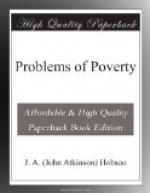The Effects of Machinery on the Condition of the Working-Classes.
Sec. 1. Centralizing-Influence of Machinery.—In seeking to understand the nature and causes of the poverty of the lower working-classes, it is impossible to avoid some discussion of the influence of machinery. For the rapid and continuous growth of machinery is at once the outward visible sign and the material agent of the great revolution which has changed the whole face of the industrial world during the last century. With the detailed history of this vast change we are not concerned, but only with its effects on the industrial condition of the poor in the present day.
Those who have studied in books of history the industrial and educational condition of the mass of the working populace at the beginning of this century, or have read such novels as Shirley, Mary Barton, and Alton Locke, will not be surprised at the mingled mistrust and hatred with which the working-classes regarded each new introduction of machinery into the manufacturing arts. These people, having only a short life to live, naturally took a short-sighted view of the case; having a specialized form of skill as their only means of getting bread, they did not greet with joy the triumphs of inventive skill which robbed this skill of its market value. Even the more educated champions of the interests of working-classes have often viewed with grave suspicion the rapid substitution of machinery for hand-labour in the industrial arts. The enormous increase of wealth-producing power given by the new machinery can scarcely be realized. It is reckoned that fifty men with modern machinery could do all the cotton-spinning of the whole of Lancashire a century ago. Mr. Leone Levi has calculated that to make by hand all the yarn spun in England in one year by the use of the self-acting mule, would take 100,000,000 men. The instruments which work this wonderful change are called “labour-saving” machinery. From this title it may be deemed that their first object, or at any rate their chief effect, would be to lighten labour. It seems at first sight therefore strange to find so reasonable a writer as John Stuart Mill declaring, “It is questionable if all the mechanical inventions yet made have lightened the day’s toil of any human being.” Yet if we confine our attention to the direct effects of machinery, we shall acknowledge that Mill’s doubt is, upon the whole, a well founded one.
According to the evidence of existing poverty adduced in the last chapter, it would appear that the lowest classes of workers have not shared to any considerable degree the enormous gain of wealth-producing power bestowed by machinery. It is not our object here to discuss the right of the poorer workers to profit by inventions due to others, but merely to indicate the effects which the growth of machinery actually produce in this economic condition. Let us examine the industrial effects of the growth of machinery, so as to understand how they affect the social and economic welfare of the working-classes.




